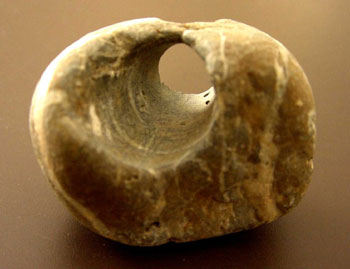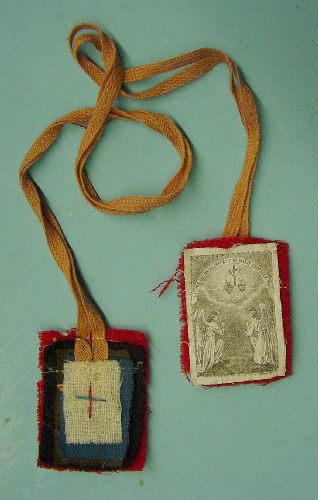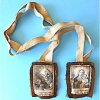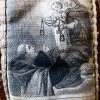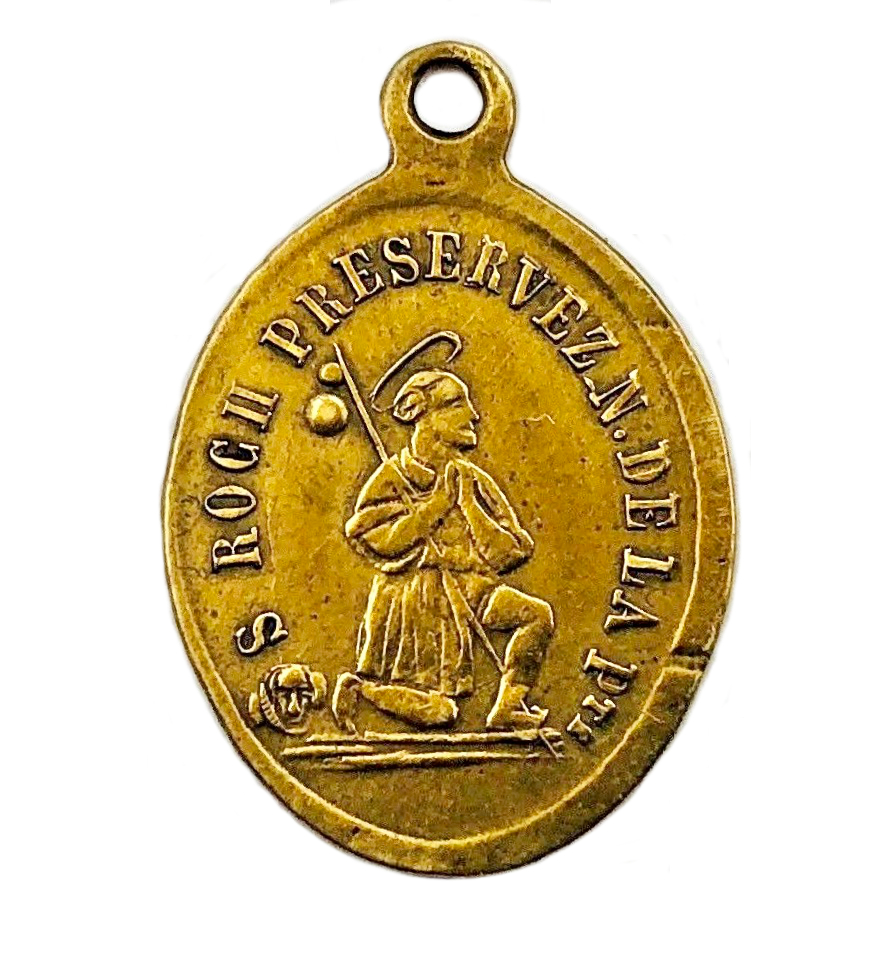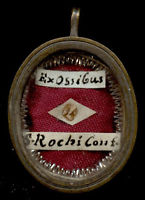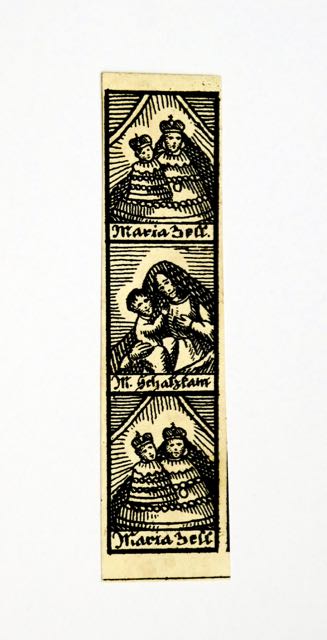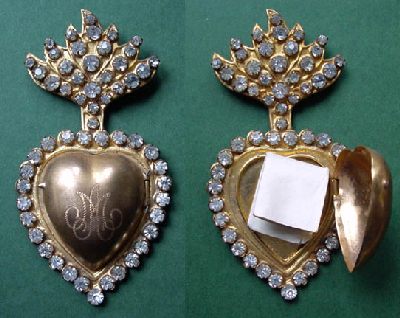Amulets |
||
Pissing stone |
||
Spontaneously perforated stones have stimulated people's imagination for hundreds of years, as well in the Alps as on the coast of the Northern sea. In Bavaria they wore them as amulets around their neck in order to be preserved from witchcraft - and pissed through the hole (which led to the name "Brunzelstein". I am asking myself if the magic force attributed to this particular stones wasn't in any relationship to the worms, which were held for causing inner illnesses and toothache. Didn't the holes look like the traces of such a worm, as if the stone had been able to get rid of such an invader: the stone mightier than a worm ...
This explains the power attributed to the "Trude"-stones: "Die Wirkung des Trudensteines galt als apotropäisch gegenüber dem schädlichen Einfluss von Zauberinnen und Unholdinnen; er musste über ein Loch verfügen und möglichst klein sein" (Britta-Juliane Kruse, Die Arznei ist Goldes wert, mittelalterliche Frauenrezepte, 1999 p. 165).
Christianity of course didn't appreciate this view and banished the holes and the worms into the remotest corners of the farms: "Im Volk haben solche Steine den Namen „Hühnergott“ bekommen. Vor langer Zeit hielt man Steine mit natürlich entstandenen Löchern für Talismane, die Hühner vor Behexung und böser Geister schützten, der Züchtung und der Fruchtbarkeit der Hühner beitrugen. Der „Hühnergott“ sollte die Hühner vor allem vor Domowoj und Kikimora schützen (böse Geister), die ihnen Federn ausrupfen. Manchmal konnte man statt des Steines auch eine Scherbe mit Loch oder einen Hals vom zerschlagenen Krug als Hühnergott benutzen. Ich weiß nicht, ob solche Talismane auch jetzt irgendwo in Dörfern benutzt werden, die Steine mit Löchern aber sind auch heute als Gegenstände bekannt, die magische Kraft besitzen und von Menschen als Glücksbringer wahrgenommen werden" (Oksana) "Auch in Norddeutschland sind diese besonderen Steine weit verbreitet, meist sind es Feuersteine mit Kalkeinlagerungen, die mit der Zeit ausgewaschen werden. In früheren Zeiten wurden diese Steine gesammmelt und neben oder über der Haustür angebracht. Sie sollten dort böse Geister fernhalten.Auch heute ist es schön, an der Ostsee beim Strandspaziergang solche Steine zu finden. Manche haben so viele Löcher, daß die Steine fast wie ein Schwamm aussehen. Und als Talisman sind sie immer noch schön" (Doro, Internetforum).
The 4 cm diameter stone we show here lay on the small beach of Lissos on the southern coast of Crete where we gathered it in 2001 ...
Intern Links: UK: https://www.kugener.com/en/amulette-fr/65-artikel/2587-brunzel-stein-3.html FR: https://www.kugener.com/fr/amulette-fr/65-artikel/2585-brunzel-stein-2.html DE: https://www.kugener.com/de/amulette-en/65-artikel/993-brunzel-stein.html
|
Amulets |
||
Scapular (1) |
||
The scapular originated from the cloak of the Carmelite Order's garb in the Middle Ages. The robe showed images of Our Lady of Carmel and the Heart of Jesus, for protection against evil.
In some places, once every child and almost every adult wore a scapular, with the children a "simple", the adults mostly a "five-fold" had. The simple scapulars were consecrated on the "Skapuliersonntag", the Sunday after July 16, by the local pastor in the church, the adult capuliers, however, were mostly consecrated by the penitents in the missions or distributed by Kapuzinerpatres. These scapulars were worn around the neck and were designed to protect against misfortune, danger and all evil spirits. The scapular amulets have occasionally been used in folk medicine to help the patient make a decision - either to die quickly and without wasting time - or to heal quickly, but not so.
Parallel object |
Amulets |
||
Scapular (2) |
||
|
St. Simon was born around 1165 in the English county of Kent. According to tradition, he lived as a hermit in a hollow tree (hence the name "stick") until 1237 Carmelites came to England. He then joined the Carmelite Order in 1241 and was elected General of the Order in 1245 in Aylesford. In 1251, at Cambridge, he appeared to the Blessed Virgin Mary, who presented him with a scapular. This scapular became part of the religious habit. The Marian apparition deepened the pious imprint of the Order. From this also the Skapulierbruderschaft developed. On 16 May 1265 Simon died during a visitation trip in Bordeaux (Wikipedia).
|
Amulets |
||
St. Rochus medal |
||
Saint Roch, bevare us from plague - these medals were worn in contact with skin. |
Amulets |
||
Relics of Saint Rochus |
||
"Ex ossibus S. Rochi conf(essoris)" - part of the skeleton of st. Rochus the Confessor. 19th century reliquary theca with sealed first class relics of saint Rochus. Similar reliquaries are rather frequent. They show, that people need heawenly assistance since ever, when suffering or when exposed to severe danger as pestilentia. *** The "Confrérie Saint Roch" was the predecessor of the master bakers association - it was NOT the love for small bread rolls that led me to buy a Rochus reliquary, but rather a whole series of medieval cultural details illuminate the relic ...
|
Amulets |
||
Swallowing picture |
||
Swallowing pictures are not a phenomenon of the Middle Ages, they are only detectable from the middle of the 18th century! Baroque home medicine, created at the same time as the filthy pharmacies ...
Lit.: Ch. Schneegass, Schluckbildchen, in: Volkskunst, Zeitschrift für volkstümliche Sachkultur 6, 1983, S. 27-32. |
Amulets |
||
Votive heart |
||
As Theresia from Lisieux died from lung tuberculosis in 1897 it is understandable that Mrs. H. adressed her prayers specially to this saint, when her husband was seriously thick with pneumonia.
Irony of destiny: while mrs. H. died in 1938, her husband survived up to 1997 ... |




